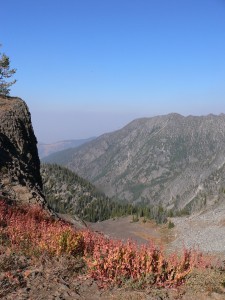Elk101.com – Elk Hunting Tip #3
As I alluded to yesterday, today’s tip would focus on locating and getting into position to set-up on a bull. This is a critical step and our approach is likely different than what a lot of hunters actually do once they get a bull to bugle. I explained the 3 primary calls we use for elk yesterday: the location bugle, the simple cow call, and the challenge bugle. We use the location bugle to, well, locate elk. I like to hike along ridgetops bugling into the adjacent drainage’s to locate a bull. Being on a ridgetop allows me the maximum mobility, providing me with the greatest opportunity to cover a lot of country in search of elk.

Ridgetop in Elk Country
Once we get a bull to respond, we begin our approach. With this method of locating, we often get a bull to answer from a long ways away. It’s not uncommon to get an answer from 500-1000 yards away. The likelihood of a bull covering 1000 yards while we sit there and bugle at him is very low. It can happen, and it has happened, but it is not something I would do if I was looking to maximize our opportunity. So here is what we do.
We bugle a couple times to get an accurate location on the bull. This also allows us to get a better feel for the bull’s attitude. If he answers every time as soon as we bugle, he is fired up and we can be more aggressive. If he only answers every other call and it takes him 5 minutes after we’ve bugled to respond, he’s timid and will have to be approached a little differently.With the bull pinpointed, we ensure we have the wind in our favor and begin our approach in silence. We go absolutely quiet and move towards the bull fairly quickly, until we feel we are within 100-120 yards. The more timid he is, the closer you’re probably going to want to get.
Sometimes, due to the terrain or other factors, we have to call to the bull during our approach to get a better pinpoint on his location. When we do this, we try to keep it as nonthreatening as we can. Just a location bugle to say “Hey, where are you?” We don’t want the bull to feel we are a threat to him or his cows…not yet. Once we get inside that magical 100-120 yard radius, we set-up. The set-up is, in my opinion, the most important and critical part of the whole “locate-approach-set up-calling” sequence. We’ll go into great detail regarding set-ups tomorrow (Tip #2). Back to our approach.
At no point during our location or approach do we threaten or challenge the bull. If we have to bugle, we keep the conversation somewhat “friendly”. We then go absolutely quiet and head towards the bull. The wind can be your best friend or your greatest enemy. Be sure it is on your side as you approach the bull. Also take extra care to remain silent. You do not want the bull to have any indication you are heading his way. He should just assume you have left the drainage peacefully or that you have no interest in him or what he’s doing there. If he gets a little uncomfortable not knowing where you are he might bugle once or twice and that is exactly what you want. You’re able to keep him pinpointed without giving up your location.
I will tell you this – knowing there is a bull somewhere close to you and not being able to bugle at him is incredibly difficult for me to do. I want to hear him bugle! It’s an awesome sound and I want him talking as much as possible. Plus it is helpful as we move in closer to know exactly where he is. But it is important that we don’t bugle to him as we move in unless it is absolutely necessary. Pinpoint him, pick your landmark to head towards, and get there…quietly. There will be a time for bugling very soon…
Modifying your approach takes effort. It takes self-control to not bugle back when the bull bugles. It takes great care to ensure you don’t make a lot of noise as you quickly move into position. You will need to continually check the wind. However, if you are able to successfully get inside the Red Zone undetected, your odds of getting close enough to the bull to get a shot are substancially higher!
Check back tomorrow for Tip #2, the most important portion of the sequence – your set-up.
